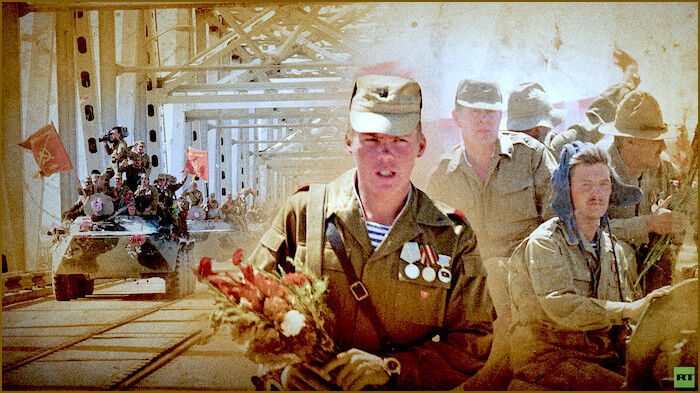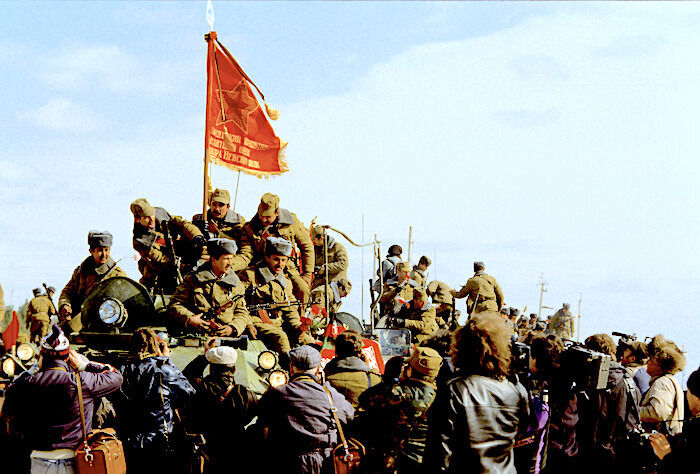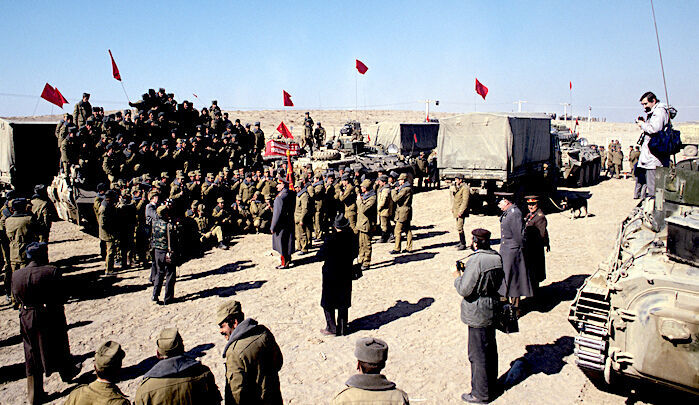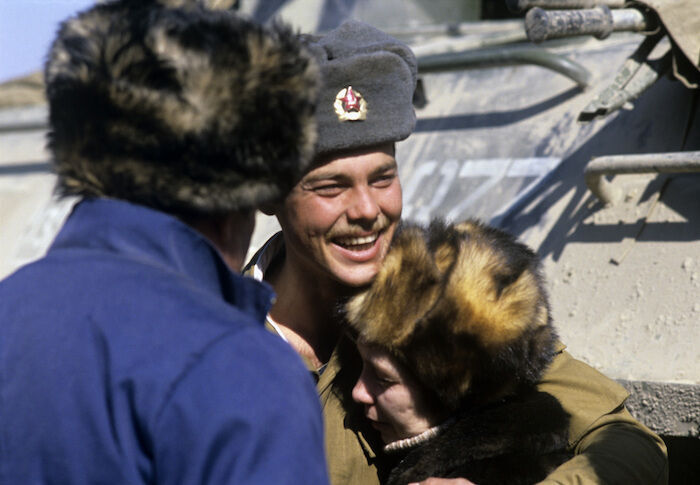On February 15, 1989, Lieutenant General Boris Gromov crossed the bridge over the Amu Darya River between Afghanistan and Uzbekistan, which was then part of the USSR. While crossing the river, Gromov uttered the historic phrase: "There is not a single Soviet soldier left behind me."
That marked the end of the nine-year Soviet-Afghan War. This conflict is often considered part of the Cold War between the USSR and the US. However, the Soviet intervention cannot be properly assessed without understanding the political situation in the Central Asian country, at the time.
Prerequisites for the invasion
For a long time, Afghanistan had been an afterthought. In the 1970s, however, the political situation became troublesome. In 1973, the monarchy collapsed as a result of a coup, and was replaced by a short-lived republic. The Soviet Union initially had friendly relations with local elites, but then, Moscow got involved in their politics. Two political sides fought for power in Afghanistan: the leftist parties - supported by the Soviet Union - and the Islamic fundamentalists.
In 1978, dictator Mohammad Daoud Khan was removed from power during a coup d'état. He was overthrown by the People's Democratic Party of Afghanistan (PDPA) - a Marxist-Leninist political party that was oriented towards the Soviet Union.
Officially, the USSR supported the revolution, but in reality Moscow had mixed feelings about the situation in Afghanistan. Even Secretary General Leonid Brezhnev was caught off-guard by the coup. Moreover, the PDPA split into several factions which fought against each other, and its members treated the teachings of Karl Marx with the fervor of neophytes.
Afghanistan was one of the poorest and most archaic nations in the world. The PDPA's leaders were enthusiastic about implementing reforms and changing this situation. However, even the most reasonable reforms were carried out in an aggressive and uncompromising manner, and the party made many enemies. Anyone who disagreed with them was imprisoned.
As a result, by 1979, a civil war had broken out. The government asked the USSR to provide a small army contingent to help maintain security in the capital city, Kabul. The KGB's "Zenit" special forces unit and a paratrooper battalion were sent to Afghanistan. But soon, the situation in the country escalated further. The leader of the PDPA party, Nur Muhammad Taraki, and his confidant Hafizullah Amin got into a conflict that ended in another coup. Amin overthrew Taraki, killed him, and declared himself the head of Afghanistan and chairman of the PDPA.
Moscow's reaction to this radical step was highly negative. Taraki was a personal friend of Brezhnev. Moreover, Amin did not want to "put all the eggs in one basket," and started negotiations with the US.
The Soviet leaders saw this as betrayal. According to Cold War logic, if Afghanistan were to join the camp of US allies, that would pose a threat to the Soviet Union. Moreover, Amin purposefully made unfriendly remarks about the country's Soviet partners, and the armed opposition gradually expanded its area of control in the country.
Big mistake
In December 1979, Moscow made one of the worst decisions in the history of the USSR: it decided to send troops into Afghanistan and eliminate Amin. The Soviet Union had already carried out successful military interventions, which weren't met with serious local resistance. The difficulties of the operation in Afghanistan were underestimated. It was assumed that the Soviet troops would help overthrow the government and replace it with a more reliable and friendly one, and then would help the Afghan army stabilize the situation in the country.
On December 27, 1979, a daring military operation was carried out in Kabul. KGB special forces units, a detachment of airborne troops, and a special forces battalion of the Soviet army made up of fighters from the Central Asian republics of the USSR broke into Amin's residence, neutralized his armed guards, and killed him. At the same time, Kabul was seized. At the time, the Afghans didn't pay much attention to what was happening - for them, it was just another coup.
Babrak Karmal, a former leftist student activist, was appointed the General Secretary of the PDPA and became the country's leader. Under Amin, he had been forced to emigrate. Now, he returned home - a decision which did not bring him much luck.
The Soviet army entered Afghanistan. It seized control of the country's key facilities and garrisoned without encountering much resistance.
The group that entered Afghanistan was formed from the 40th Army of the USSR. Additional forces were attached to it, including GRU special forces units, KGB special forces, border units, etc. This formation was known by the lengthy name "The Limited Contingent of Soviet troops in Afghanistan" (LCSA).
The military operations that took place during the Afghan War are a separate and lengthy subject; what is more interesting is how the situation on the ground changed as a result of the war, and what conclusions the leaders came to.
Afghanistan's new leader, Babrak Karmal, understood that the country's troubles wouldn't end with the entry of Soviet troops - on the contrary, it signified the start of a major conflict. As President, Karmal released the country's political prisoners - a total of over 15,000 people - implemented social measures, provided assistance to peasants, and so on. However, the civil war in Afghanistan continued and took a new turn - it became a national and religious war against foreign invaders.
However, the Soviet Union didn't just enter Afghanistan with weapons in hand. Apart from military personnel, many technical specialists and people who were supposed to help with local management were sent to the country.
However, Soviet people did not understand the local culture. For example, Mikhail Anisimov was appointed an adviser to the administration of Baghlan province. Anisimov was a military man, but he had to deal with civilian issues. In the province which he was supposed to manage, there was almost no civil infrastructure, and there were problems with the supply of clean water. He didn't know the language - a problem which his enthusiasm and energy couldn't make up for. Naturally, before learning to do things the right way, Anisimov made many mistakes. For example, as a Soviet man, Anisimov was raised an atheist - but it turned out that the most authoritative people in Afghanistan were mullahs [Muslim clergy]; when he tried to carry out land reforms, the peasants didn't even want to cultivate the land which they were given, since they were used to feudalism; and when a local worker got an apartment, he did not move into it, because the neighbor's wife did not cover her face, and the devout Muslim could not bear to look at such sacrilege.
In short, even at a basic level, there were many misunderstandings.
Swamp of War
Meanwhile, the army continued fighting. At first, Soviet troops were only supposed to support Afghan government forces. However, reality forced them to adapt to the circumstances.
During the Cold War, the Soviet army was preparing to fight NATO in a hypothetical World War Three. But in Afghanistan, Soviet troops were attacked by guerrilla groups which posed a threat to supply columns that traveled slowly along the roads. The "limited contingent" was too small to control the country's entire territory, and the Afghan government forces were not strong enough to help. As a result, Soviet units controlled large cities and the main roads, but everywhere in between, the militants reigned. At first, Islamic guerrillas were simply called bandits, but over time, they became known as "dushmans" ("enemies" or "opponents" in the local dialect), or respectfully as "Mujahideens" - i.e. "warriors for the faith". The word "dushman" was often shortened to "dukh" - a similar-sounding Russian word meaning "spirit, ghost."
The war with the "spirits" soon spun out of control. Battles intensified, and the roads were strewn with landmines. To solve this problem, Soviet troops carried out large-scale operations in the course of which they cleared large parts of the territory. However, such campaigns were not very successful.
For example, the Soviet army would drive Islamic guerrillas out of a particular village, but since there weren't enough Soviet troops maintain control and the official Afghan army had limited combat capacity, the militants would return immediately. Moreover, many civilians died as a result of bombing and attacks, and locals would then be motivated to join the militants to avenge their deaths.
Almost the entire world supported the guerrilla groups. The US, China, Pakistan, Iran, as well as European NATO and Arab countries all supported the "dushmans" in some way. There was a constant flow of weapons across the Pakistani border. Under the guise of fighting against Soviet troops, new local field commanders came to power- such as Ahmad Shah Massoud, who fought in the Panjshir Valley. In 1982, the major field commanders formed the "Peshawar Seven", also known as the "Afghan Mujahideen" - an alliance of political, military and religious leaders.
The Soviet military was brave and skilled. Raids on the rear positions of the Mujahideen were extremely effective operations in terms of military art, but they did not change the course of war.
After Brezhnev's death, Yuri Andropov came to power in the Soviet Union. He believed that the war was merely a another footnote in Afghan history -and that sooner or later, economic and social development as well as military efforts would put an end to the resistance.
This would have probably been the best scenario for Afghanistan, which was torn apart by internal contradictions. But this view was overly optimistic. Negotiations with other countries were unsuccessful. The US considered it a brilliant trap for the USSR. The leaders of the Islamic opposition wanted to overthrow the government in Kabul. The war continued and became increasingly violent. With the help of special forces, Soviet troops tried to carry out Operation Zavesa ("Veil") to prevent weapons from entering Afghanistan. This time too, the operation was a brilliant tactical success, soldiers and officers performed remarkable feats, the army acquired war trophies, many enemies were killed ... but all of that didn't change the course of history.
The second half of the '80s was marked by discussions on how to put an end to the intervention. The USSR's new Secretary General, Mikhail Gorbachev, was determined to end the conflict. Mujahideen fighters also faced problems. Soviet military and civilian leaders had adapted to the terrain and the local culture, young Afghans traveled to the Soviet Union to study, and the local army had been restructured and reinforced. The aforementioned administrator of Baghlan province, Mikhail Anisimov, spoke with irony about the new "kissing policy": he had to individually negotiate with field commanders in Baghlan, and in the course of these agreements, had to "kiss a lot of bandits." However, the strategy worked - - the implementation of peaceful economic policy in his province yielded real results. Some proposals were quite peculiar: for example, mullahs were simultaneously appointed as communist secretaries of party organizations. Orthodox Marxists would have had a heart attack if they found out about this, but the strategy worked.
However, the right approach was found too late. In the Soviet Union, the war was very unpopular and caused many disputes in society. People did not understand why their friends and relatives were sent to fight in a foreign country and returned home crippled or dead. The Afghan war gave rise to the darkest term of the late Soviet era - "Cargo 200". That is what coffins with the bodies of the dead soldiers were called since the coffin, transport box, and body itself were assumed to weigh a total of 200 kg. To this day, the Russian word "dvuhsoty" ("two hundredth") implies a person who died at war.
Around this time, President Babrak Karmal started to neglect his duties, became an alcoholic, and left office in 1986. He was succeeded by Mohammad Najibullah, who tried to pursue a policy of national reconciliation. Najibullah was a determined and intelligent man, and he tried to stop the war. Refugees returned to their homes, and many militant groups laid down their arms as a result of the truce announced by Najibullah. Elections were announced and he became President in 1987.
However, these measures were implemented too late. If the right strategy had been found earlier, the USSR and the pro-Soviet Afghan government could have been victorious. But by that time, the political damage was so great that all Gorbachev wanted to do was get out of the situation.
By 1987, the frequency of Soviet military operations steadily declined and the army was gradually being withdrawn from Afghanistan.
However, it was very difficult to resolve the political conflict. No one knew what Afghanistan's future would look like - the only thing that Gorbachev could do was offer to withdraw the troops.
Soviet forces started leaving Afghanistan in 1988, and withdrew completely in 1989. In April 1988, a political settlement agreement was concluded in Geneva, and obligations were imposed on the governments of Afghanistan, Pakistan, the USSR and the US. The key point of these agreements was the official timetable established for the withdrawal of Soviet troops. Back then, these were called "breakthrough" agreements, but in reality it was like "a wedding without a bride" since the leaders of the guerilla groups did not participate in the negotiations and had no intention of fulfilling the agreements. Pakistan and the US didn't come good on their obligations either, but Gorbachev was determined to disengage.
Eventually, Soviet troops were withdrawn completely. Just as Soviet soldiers could not defeat the Mujahideen, likewise the guerilla groups were not able to conquer the Soviet army.
On February 15, the last columns of armored personnel carriers crossed the river on the border between Afghanistan and the Uzbek SSR. 100,000 Soviet soldiers had left Afghanistan. It did not look like the retreat of a defeated army. The fighters left with a strange mix of feelings: relief, a sense of having fulfilled their duty, and ... nostalgia.
For Soviet society, "Afghan" (as the country was often called in the USSR), became synonymous with collective trauma, similar to what the Vietnam War meant for Americans. The life of the war veterans - "Afghans," as they were called - became a popular theme in Russian popular culture. Many novels, movies, and songs were devoted to the "Afghan" theme, and it even gave rise to a new music genre. Sometimes, the songs crossed country borders in a surprising way. For example, an amateur music video made to the song "I am too young to die" by the pop duo Modern Talking became very popular in Russia. The song was combined with video footage of an armored personnel carrier rushing along an Afghan road (this song was actually playing in the cabin of the vehicle when the video was shot). And in 2000, a US soldier used the song "Caravan" by the Soviet bard Alexander Rosenbaum as the background music for a video of his travels along the same Afghan roads that Soviet soldiers had crossed in the '80s.
The USSR collapsed in 1991, but the veterans of the Afghan war formed an informal "brotherhood" that existed for several decades. However, confrontations arose when new wars sprang up on the ruins of the USSR, and many comrades-in-arms were forced to fight again - this time, on different sides of the barricades.
The war was over and Soviet troops had withdrawn from Afghanistan. However, peace did not return to the country. The civil war continued. The internal conflict had started before the Soviet intervention, and didn't end with it. The civil war turned out to be both longer and bloodier than Moscow's invasion.
In 1989, many people thought that Mohammad Najibullah's pro-Soviet government wouldn't be able to cope with the situation in Afghanistan. In fact, the USSR continued to supply weapons, and "Najib", as he was called in the Soviet Union, managed to keep up the resistance. In 1989, the Mujahideen attempted to occupy the city of Jalalabad, but their plan failed - Najibullah's army repelled the offensive on its own, without the help of Soviet troops.
However, in 1991, the USSR collapsed, and Najibullah lost the support on which he depended. In 1992, another coup took place, and his regime, which had existed for three years, collapsed.
As so often happens, the "victorious" side immediately started to fight amongst itself. Former Mujahideen commanders Ahmad Shah Massoud, Abdul Rashid Dostum, and Gulbuddin Hekmatyar turned against each other. Against this background, the Taliban, a religious and political movement, came to the forefront. Its members are generally viewed as terrorists. However, at the time, many Afghans saw them as a renewal force. The chaos empowered any political force that was able to dictate clear rules of the game and control the territory.
The Taliban advanced slowly but surely towards Kabul, and defeated several commanders. The fight against the Taliban was headed by Ahmad Shah Massoud, an ethnic Tajik field commander. Paradoxically, the new Russian state supported Massoud (who had been an implacable enemy of the Soviet troops during the Afghan war) since it didn't want religious radicals to come to power in Central Asia. Massoud met with many officers of the old Soviet army, against whom he had once fought. The former opponents recalled the Afghan war almost nostalgically and looked at each other sympathetically.
Meanwhile, the Taliban managed to occupy almost all of Afghanistan, and seized Kabul. President Najibullah, who was hiding in the building of the UN mission, was hanged. By then, only Massoud's united opposition forces were still fighting against the Taliban in northeastern Afghanistan. The insurgents slowly advanced to the north and by 2001 controlled over 90% of Afghanistan's territory.
In 2001, terrorists attacked the World Trade Center in New York, and the US invaded Afghanistan. Massoud was killed by terrorists just a day before the September 11 attacks, and the new war took place without him.
US soldiers quickly crossed the territory of Afghanistan... and fell into the same trap as the USSR. The 2001-2021 Afghan war is another story. It lasted for 20 years, and ended with the retreat of all US and allied forces.
Presently, Afghanistan is once again under the control of the Taliban. Fighting continues - this time the Taliban is up against ISIS terrorists. The war that deeply shook Soviet society was for Afghanistan only another part of its history, a lot of which has been filled with violence and blood.
About the Author:
Roman Shumov, a Russian historian focused on conflicts and international politics







Reader Comments